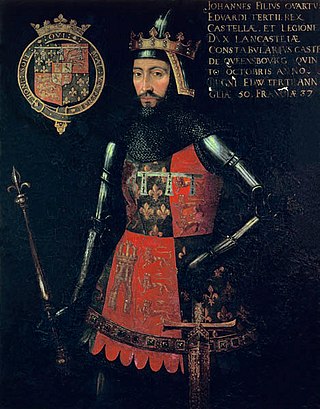| Other decades |
| 1350s | 1360s | 1370s | 1380s | 1390s |
Events from the 1370s in England .
| Other decades |
| 1350s | 1360s | 1370s | 1380s | 1390s |
Events from the 1370s in England .
The 1370s was a decade of the Julian Calendar which began on January 1, 1370, and ended on December 31, 1379.
Year 1376 (MCCCLXXVI) was a leap year starting on Tuesday of the Julian calendar.

John of Gaunt, Duke of Lancaster was an English royal prince, military leader, and statesman. He was the fourth son of King Edward III of England, and the father of King Henry IV. Due to Gaunt's royal origin, advantageous marriages, and some generous land grants, he was one of the richest men of his era, and was an influential figure during the reigns of both his father and his nephew, Richard II. As Duke of Lancaster, he is the founder of the royal House of Lancaster, whose members would ascend the throne after his death. His birthplace, Ghent in Flanders, then known in English as Gaunt, was the origin of his name.

Edmund of Langley, 1st Duke of York was the fourth surviving son of King Edward III of England and Philippa of Hainault. Like many medieval English princes, Edmund gained his nickname from his birthplace: Kings Langley Palace in Hertfordshire. He was the founder of the House of York, but it was through the marriage of his younger son, Richard of Conisburgh, 3rd Earl of Cambridge, to Anne de Mortimer, great-granddaughter of Edmund's elder brother Lionel of Antwerp, 1st Duke of Clarence, that the House of York made its claim to the English throne in the Wars of the Roses. The other party in the Wars of the Roses, the incumbent House of Lancaster, was formed from descendants of Edmund's elder brother John of Gaunt, 1st Duke of Lancaster, Edward III's third son.
The Good Parliament is the name traditionally given to the English Parliament of 1376. Sitting in London from April 28 to July 10, it was the longest Parliament up until that time.

Edmund Mortimer, 3rd Earl of March and Earl of Ulster was an English magnate who was appointed Lieutenant of Ireland but died after only two years in the post.

John Devereux, 1st Baron Devereux, KG, was a close companion of Edward, the Black Prince, and an English peer during the reign of King Richard II.

The House of Plantagenet was a royal house which originated in the French County of Anjou. The name Plantagenet is used by modern historians to identify four distinct royal houses: the Angevins, who were also Counts of Anjou; the main line of the Plantagenets following the loss of Anjou; and the houses of Lancaster and York, the Plantagenets' two cadet branches. The family held the English throne from 1154, with the accession of Henry II, until 1485, when Richard III died.

Owain Lawgoch, full name Owain ap Thomas ap Rhodri, was a Welsh soldier who served in Lombardy, France, Alsace, and Switzerland. He led a Free Company fighting for the French against the English in the Hundred Years' War. As a politically active descendant of Llywelyn the Great in the male line, he was a claimant to the title of Prince of Gwynedd and of Wales.

The Caroline War was the second phase of the Hundred Years' War between France and England, following the Edwardian War. It was so-named after Charles V of France, who resumed the war nine years after the Treaty of Brétigny. The Kingdom of France dominated this phase of the war.
Events from the 1340s in England
Events from the 1360s in England.
Events from the 1380s in England.
Events from the 1400s in England.
Events from the 1410s in England.
Events from the 1420s in England.
This article is about the particular significance of the century 1301–1400 to Wales and its people.

William Ufford, 2nd Earl of Suffolk was an English nobleman in the reigns of Edward III and Richard II. He was the son of Robert Ufford, who was created Earl of Suffolk by Edward III in 1337. William had three older brothers who all predeceased him, and in 1369 he succeeded his father.
Sir Walter Devereux of Bodenham was a prominent knight in Herefordshire during the reign of Edward III. He was a member of Parliament, sheriff, and Justice of the Peace for Hereford.

John of Gaunt's chevauchée of 1373 was an English military raid at the end of the second period of the Hundred Years' War by John of Gaunt, Duke of Lancaster, from his departure from Calais in August 1373 to his arrival at Bordeaux at the end of December 1373.